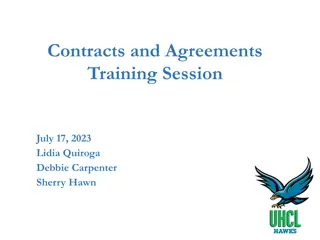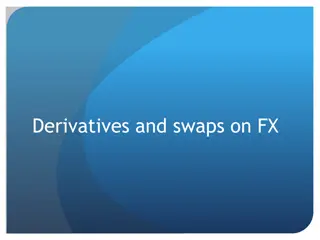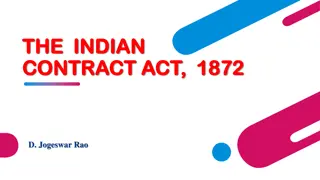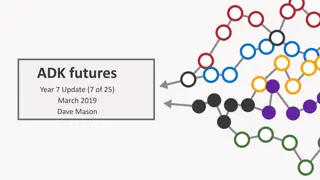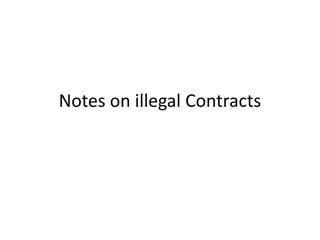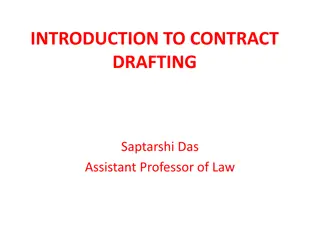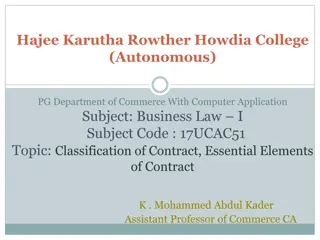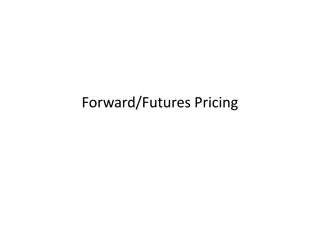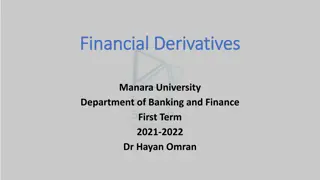Understanding Futures Contracts: Features and Examples
Futures contracts are standardized agreements between buyers and sellers, marked-to-market daily to manage risk. Features include maintenance and initial margins, with gains and losses reflected in margin accounts. Examples illustrate how to calculate gains and losses in futures trading scenarios.
Download Presentation

Please find below an Image/Link to download the presentation.
The content on the website is provided AS IS for your information and personal use only. It may not be sold, licensed, or shared on other websites without obtaining consent from the author. Download presentation by click this link. If you encounter any issues during the download, it is possible that the publisher has removed the file from their server.
E N D
Presentation Transcript
Chapter#1 FUTURES Salma Alsuwailem
Summary A futures contract is a standardized agreement, similar to a forward contract, where buyers and sellers post a margin and the contract is marked-to-market (usually daily). Feature Forwards Futures Customization Can be customized Standardized Not "marked-to-market"; settlement made on expiration date only "Marked-to-market"; often settled daily Marked-to-Market Less risky since marked-to- market Credit risk Riskier Relatively illiquid and traded over-the-counter Liquidity Liquid and exchange-traded Pricing Limits Not applicable Applicable 2 Salma Alsuwailem
FEATURES OF FUTURES CONTRACTS Maintenance & Initial Margins To protect against the risk of default, the futures contract requires both the buyer and seller to make a deposit into an account that earns interest (called a margin account). The initial margin deposit required is called the initial margin. Gains and losses are added to and subtracted from the margin account as futures prices change. Because the balance in the margin account can fluctuate, a minimum margin level is often required, called a maintenance margin. 3 Salma Alsuwailem
To calculate the gain on a long futures contract, use the following recursive formulas: 4 Salma Alsuwailem
example Judy decides to take a short position in 20 contracts of S&P 500 futures. Each contract is for the delivery of 250 units of the index at a price of 1500 per unit, exactly one month from now. The initial margin is 5% of the notional value, and the maintenance margin is 90% of the initial margin. Judy earns a continuously compounded risk-free interest rate of 4% on her margin balance. The position is marked-to-market on a daily basis. On the day of the first marking-to-market, the value of the index drops to 1498. On the day of the second marking-to-market, the value of the index is X and Judy is not required to add anything to the margin account. Calculate the largest possible value of X. (A) 1490.50 (B) 1492.50 (C) 1500.50 (D) 1505.50 (E) 1507.50 5 Salma Alsuwailem
An investor enters a long position in a futures contract on an index (F) with a notional value of 200 F, expiring in one year. The index pays a continuously compounded dividend yield of 4%, and the continuously compounded risk-free interest rate is 2%. At the time of purchase, the index price is 1100. Three months later, the investor has sustained a loss of 100. Assume the margin account earns an interest rate of 0%. Let S be the price of the index at the end of month three. Calculate S. (A) 1078 (B) 1085 (C) 1094 (D) 1105 (E) 1110 6 Salma Alsuwailem
An investor takes a long position in 50 futures contracts of the S&V Index. Each contract is for the delivery of 500 units of the index. The futures price of the index is 1,000. You are given: The initial margin requirement is 8%. The maintenance margin is 80% of the initial margin. The margin account earns an annual continuously compounded interest rate of 5%. After 1 day, the futures price is 990. After 2 days, the futures price is 995. After 3 days, the futures price is 980. After 4 days, the futures price is 970. Calculate the amount in the investor's margin account after 4 days. A 1,250,976 B 1,500,771 C 1,750,274 D 1,875,514 7 Salma Alsuwailem E 2,000,000
Thane takes a short position in 40 contracts of the ABC Index futures. Each contract is for the delivery of 500 units of the index. The futures price of the index is 1,220. The initial margin is 10% of the notional value, and the maintenance margin is 80% of the initial margin. The futures contract is marked-to-market daily. Assume there are 365 days in a year. After one day, the futures price decreases to 1,200. After two days, the futures price increases to 1,270. After three days, the futures price decreases to 1,250. The margin account earns an annual continuously compounded interest rate of 5%. The annual continuously compounded risk-free interest rate is 3%. Calculate Thane's profit after three days. A -2,840,334 B -999,277 C -599,626 D 599,626 8 E 2,840,334 Salma Alsuwailem
An investor enters into a long position on four futures contracts, each having a current futures price of 27,800. All contracts expire one year from now. The investor is required to deposit 55,600 initially into a margin account, which represents 10% of the total notional value of the investor's position. There is no maintenance margin. Proceeds are marked-to-market monthly, and the margin balance is credited with interest at a continuously compounded rate of 7% per year. One month later, the futures price falls to 27,750. Calculate the investor's margin balance in one month. A 54,170 B 54,295 C 54,500 D 54,675 E 54,925 9 Salma Alsuwailem
THANKS! Any questions? https://youtu.be/Njy9wm4dOZc 10 Salma Alsuwailem



